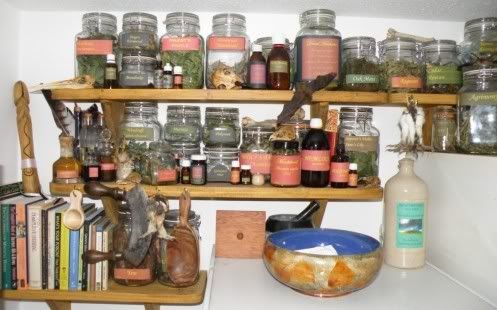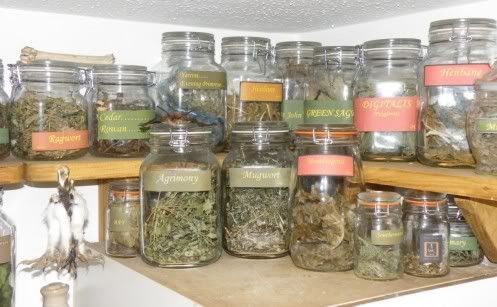THE ART OF WORTCUNNING
(Well a few basics anyway)


Several well stocked shelves packed with dried herbs, bottles of herb extracts, tintures and salves will pay dividends in your magical workings
We are not Horticultural experts in any meaningful description of that word, but we do have several decades of experience in growing the most oft used magical herbs…. Some might say, and with some accuracy that the herbs we as a Coven tend to grow, are used for the darker side of magic. We of course disagree, to us there is only magic, no black, no white, just magic. We leave the definitions of shades to our friends, the Wiccans. Buying prepared potions or dried herbs is not the best option. Not unless you personally know the grower so you can be sure of the purity of your purchase….. So, grow your own…… Hey come on…you’re a witch, it really isn’t that difficult and you can’t, or shouldn’t get your Wiccan or Traditional 3rd degree without knowledge of herb lore. So give it a go…. You’ll have a few failures and Yea!!! its frustrating, but you’ll get there and it truly is worth it. Space isn’t a problem, even the tiniest of gardens can grow huge amounts of herbs, and most look and smell great too. OK I concede that Henbane and Mandrake aren’t exactly beautiful, but their worth overcomes that and you can always hide them in amongst the more pleasing plants. Even a window box can grow almost anything…..
ONE POINT TO REMEMBER SOME OF THESE HERBS ARE POISONOUS AND THEY DON’T MIX WITH CHILDREN AND PETS
To prove our point about the limited space needed these photo’s show our small courtyard garden in June…….


Most native wild herbs are either annuals or bi-annuals….. And all will self seed to a lesser or greater extent. Collecting seeds, sun drying them and storing them until the following spring is a very spititual way of populating your garden with magical herbs for the next year. Although some species, like Henbane are better as 2nd year plants so allow late summer self sown seeds to thrive and your harvest will be much greater the following summer. We can’t go through every useful herb, it would require a website all of its own but here are some of the herbs and their uses, that we use most often.
DRAGON WORMWOOD ( Artemisia dracunulus)

All the Artemisia family are particularly attuned to Lilith (especially important to this Coven)
Properties similar to Wormwood Absinthium detailed below. but with specific relevance to Lilith potions
SKULLCAP

Skullcap is a tranquiliser, similar, if milder effects, to cannabis. Used in ‘journeying’, ‘astral project’ and in Tantric Yoga
WARNING….not to be used in conjunction with any prescribed tranquilisers……
POKE / POKEROOT POISON

Used to break hexes and curses……Berries can be made into ink for spellwork….. aids Courage
HENBANE

Henbane is well known as a witches plant and is much feared even today, in fact probably more so in this PC/Health and Safety obsessed world.It is a plant of the element of Water and is famous for its capabilities to enduce ‘ Flying ‘ It contains scopolamine, atropine and hyscyamine. Ancient lore dictates that when worn, this herb attracts love and lust. The dried herb when burned brings rain (fumes poisonous) The recipes for flying ointments are many and diverse…. Probably best not to play with fire if you are a novice…… Henbane grows easily, all it requires is a temperature of 14 degrees to germinate and once past the seedling stage it can just about withstand anything. It thrives on waste grounds and so don’t over fuss it and you’ll see great results.
MONKSHOOD/WOLFSBANE (Aconite)


Monkshood and Wolfsbane are both of the Aconite family and are very similar
It is a plant of the element of Water and used for Protection. It contains Aconitin and various Alkaloids
Herb lore dictates that it protects from werewolves and can be used to instill invisibility. All parts of this plant are poisonous and do not rub any part of the plant on the skin. Grows well in full sun and will spread by way of a tuberous root system. Dig up, split and replant when too large a plant has grown.
SOUTHERNWOOD ’ Artemisia Abrotanum’

Comman names describes its purpose pretty well ( Maid’s Ruin)
Used as an incense particularly at Beltaine… Said to promote lustful thoughts and actions…. (not that anyone in this coven needs much persuasion in that quarter)
MANDRAKE

This plant is under the element of Fire
Herbal Lore tells us that a root placed above your hearth and another over your door will protect you from harm and bring wealth and fertility to your home. Again this plant is poisonous but its root, whether whole, dried or sliced is vital to many a spell and growing it is an essential part of the art of Wortcunning.
WORMWOOD in particular (Artemisia absinthium)

This plant is also under the element of Fire… All the Artemisia family are particularly attuned to Lilith (especially important to this Coven)
Wormwood is one of the prime ingredients in ABSINTHE……….. and as such is still important in many a love potion. Dried Wormwood has many uses, it can be used in psychic progressions, to aid shamanic journeying and to summon the Spirits.
WOAD

This plant needs no explanation… Woad is a dye plant used since pre history to dye clothes and skin…. easy to grow, making the dye…not such a simple task….
VALERIAN (Common)

This plant is under the element of Water
Valerian is basically a plant of protection but it is also used in homeopathy for a variety of uses… such as IBS, Eczema and Nervous disorders.
The crushed root is often used when spells call for ‘graveyard dust’
HEMLOCK


Not a plant to be played with
A plant dedicated to Hecate…..Should need to say no more…Contains powerful alkaloids. Shamanic journeying was its prime use but it is also used to purify and cleanse new magical blades.
Can be found wild all over Britain but very easily confused with the far more common wild parsnip…….
FOXGLOVES digitalis purpurea or more commonly WITCHES BELLS

A plant again under the element of water…a plant for protection…. A black dye can be produced from the leaves and the A.C. use that dye when writing spellwork for hexing. Witches Bells was, and sometimes still is, used for heart trouble and depression. Yet again, a poisonous plant. Grows wild throughout Britain, usually on road verges, waste ground and especially on disturbed heathland. The cultivated varieties are equally as poisonous but far less effective for witchy purposes……..perhaps man’s interference has destroyed or altered the plants natural energies.
** http://alltacailleach.wordpress.com/growing-herbs-where-which/ **
No comments:
Post a Comment